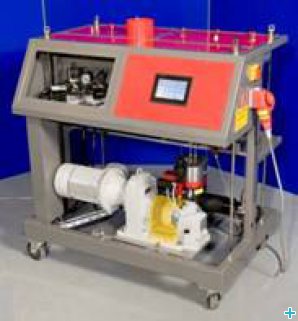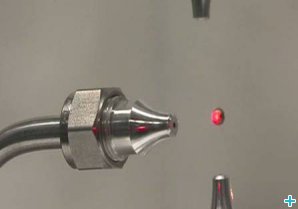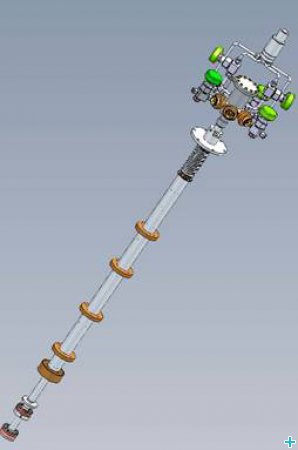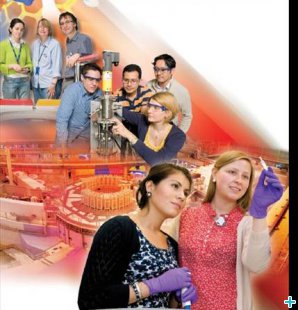The Sample Environment JRA
The Sample Environment JRA is a far-reaching collaboration whose aim is to enhance the capabilities of sample environment available at European neutron facilities, in order to expand the users’ research possibilities in these facilities. New sample environments will open up new territories for hydrostatic pressure, temperature and advanced gas adsorption facilities; pushing at the boundaries of in-situ experimentation. Significant progress has been made in overcoming the technical challenges associated with these advances in sample environment. This has been greatly aided by the continual sharing of knowledge and experience between the technical groups at member facilities. This JRA provided a breath-taking array of new sample environment equipment and experience in much desired but technically very challenging areas, opening up new realms of scientific exploration.
High pressure gas cells
High-pressure research is one of the fastest-growing areas of natural science, and one that attracts such diverse communities as those of physics, bio-physics, chemistry, materials science and earth sciences. In condensed matter physics there are a number of highly topical areas such as quantum criticality, pressure-induced superconductivity or non-Fermi liquid behaviour, where pressure is a fundamental parameter. An increase in the range of available pressures up to 10kbar for gas-loaded cells makes a significant impact on the range of science possible at neutron facilities. However, high pressure gas sample cells require thick cell walls which may lead to an unacceptable neutron background and thus the choice of materials and geometries is critical to improving the quality of the data. Reliable, safe and user-friendly high pressure gas handling systems are also an essential part of the development.
The aim of this task was to provide a range of containers (cells) for high pressure gas samples and suitable pressure-generating equipment. An extensive investigation into potential materials was carried out, supported by material testing carried out by students at Imperial College London. To complement the test data the collaboration used experimental results from the Engin-X diffractometer at ISIS and extensive finite element analysis (FEA) to aid design. All the cells specified were made and tested successfully (fig 1). Most were made from beryllium copper, but for high temperature 4 kbar hydrogen Inconel was used because the data showed that beryllium copper is not suitable at elevated temperatures.
For 8 kbar hydrogen a composite cell with a hydrogen-resistant beryllium copper liner and a neutron-transparent outer of titanium zirconium was used in order to increase the neutron transmission through the cell. To enable the full exploitation of this suite of high pressure cells, a support network of safety features, testing facilities and gas handling systems was also produced. This equipment included gas ‘intensifiers’, which compress the gas to pressures over 10 kbar – 10,000 times atmospheric pressure. The ISIS test area was updated and strengthened, and has already been used by LLB. The LLB produced a cryogenic system in order to fully test their cells at low temperature. LLB and ISIS procured 10 kbar inert gas intensifiers and ISIS extended the range of their hydraulic intensifier to over 13 kbar. Both the HZB and ISIS constructed 10 kbar hydrogen intensifiers (fig 2). These new pressure cells and equipment have doubled the pressures available to LLB and ISIS users. Several of the cells have already been successfully used for experiments at ISIS and HZB.
High temperature furnaces
Studies of the liquid state are not only significant from a fundamental point of view but also represent important technological interests. The molten state is an essential stage in various industrial processes. However, the study of structure and dynamics in liquid metals or dielectric materials is often prevented by the chemical reaction of the high temperature melt with its sample holder. As part of this JRA, two furnaces were developed for different sample types: an aerodynamic version at the ILL and an electrostatic version at FRM II. An aerodynamic furnace uses high speed gas jets to suspend the sample; an electrostatic furnace levitates charged samples using electric fields.
Existing aerodynamic furnaces were not suitable for experiments on neutron beamlines because of sample instability and sample access: only two-thirds of the molten sample volume was generally visible to the neutron beam. The neutrons scattered by the nozzle also created unwanted background scatter, leading to data analysis problems. These were significant problems to overcome but after many trials of different gas nozzle types, geometries and flow rates, a solution was found. The novel four-nozzle technique developed allows the stable levitation of a sample up to 6 mm in size, unobscured by the nozzle. It is also now possible to change the atmosphere in which the sample is heated, for example by the introduction of a small proportion of oxygen or carbon dioxide. Figure 3 shows a levitated sample during heating. Experiments may now be carried out at temperatures up to 3000 K, a temperature never before obtained on a neutron beamline.
The main task facing the FRM II team working on the electrostatic furnace was to adapt an existing system to fit the spatial constraints of a neutron scattering instrument. The system also needed an upgrade to levitate the larger samples required for the neutron beam, as well as improvements to portability, reliability and user handling. Working in partnership with the German Aerospace Centre (DLR) an improved and compact furnace has been made. It has been tested and used for neutron scattering experiments on beamlines at both the FRM II and ILL. The system has fulfilled all its specifications and the addition of a laser pre-heating stage now removes unwanted organic material from the surface of the sample as well as dissolved gases and other contamination of the bulk material. This results in a more reliable and faster melting process and aids the processing of new sample systems.
Gas Adsorption Control Systems
Gas adsorption is the process by which components of a gas adhere to the surface of a sample. Volumetric analysis determines the extent of adsorption by measuring the change in sample volume; gravimetric analysis by measuring the change in sample weight. The technique of gas adsorption is very important for the measurement of hydrogen storage materials and the characterisation of chemical and catalyst reactions in porous materials.
The greatest challenge to the HZB team was overcoming the complexity of automating the supply of an accurate measure of gas to the sample for the adsorption process. The difficulties of providing a range of multipurpose apparatus, suitable for neutron beamline use, which was safe, user-friendly and flexible were also significant. New construction materials had to be investigated and were rigorously tested under extreme conditions before approval. Important safety measures had to be taken to provide protection against possible material failures. To avoid compromising accuracy or performance, specialised equipment was developed for specific sample conditions.
The range in volumetric systems was initially increased with the development of systems for the in-situ measurement of gas adsorption at a specific temperature, at low pressure and in the temperature range 1.5 to 600 K. New equipment includes a cryo-furnace insert and a mini mechanical cooler version for use on neutron beamlines with restricted access. In addition, we have developed accessories to facilitate the supply of gas to the sample including a glove-box insert and a self-locking sealed sample can. We then built a gas handling system with automated control, operating at up to 200⁰C and 300 bar. This comprehensive system incorporates an oven to heat the gas supply tubes to the sample, ensuring that the vapour condenses in the correct place for analysis. A residual gas analyser has also been adapted for the system to provide chemical composition information for experiments related to reactions and catalytical processes. This gas handling system has been in successful operation for experiments since July 2012.
For gravimetric analysis we have adapted an existing magnetic suspension balance for neutron scattering experiments. A magnetic suspension balance weighs samples without contact, separating the weighing instrument from the sample which may be in a corrosive atmosphere or under extreme temperature and/or pressure conditions. Firstly, to guarantee a reproducible sample position with respect to the neutron beam, a mechanical depositing rack has been added. Secondly, a high pressure hydrogen vessel for the balance has been designed and made, incorporating a hydrogen-resistant liner and a neutron-transparent outer casing. Thirdly, a control system allowing the application of either variable gas mixtures or humidities has been developed. This system can remotely regulate the gas flows, the temperature (to 500⁰C) and the pressure (0.5-35 bar) of the sample container on the balance. To this was added a high pressure (up to 300 bar) gas handling system, built together with an industrial partner, which allows very precise sample pressure control. Finally, the working range for gravimetric analysis on the neutron beamline has been extended still further down to cryogenic temperatures, -250⁰C and below. A customised helium flow cryostat had to be designed as no existing system was suitable. The sample holder is cooled by contact with the cryostat heat exchanger and magnetically coupled to the suspension balance by a thin fibre to minimise heat transfer, and then lifted for sample weighing. A series of thermal radiation shields helps to maintain a constant temperature around the sample whilst allowing almost 360⁰ neutron beam access to the sample. The advanced performance and automated control of these adsorption systems has successfully increased the rate of experiments at the HZB.
In addition, to complement the equipment described above, the ILL, in cooperation with HZB and ANSTO, Australia, has developed an improved version of a gas adsorption stick. This stick combines volumetric, continuous flow and gas mixing applications together with a standard sample cell design (fig 4). This stick is easy to use and maintain, and provides users at different neutron facilities with a standardised piece of equipment. It has already been successfully used in several experiments.
Impacts on science
The greatest impact this sample environment JRA will have is on science – moving boundaries and extending experimental ranges. For example, the advances in high pressure equipment will enable further exploration in the areas of condensed matter physics, planetary and geo-science – studies of high pressure gases, which mimic conditions on other planets or inside our own – and high pressure hydrogen research, which may yet provide the answer to global energy problems.
The development of two types of levitation furnace will allow studies of high temperature melts across a broad range of both conducting and non-conducting materials not possible before. Studies of the molten state are not only of interest for fundamental research, but are also very important for technology. It is an essential stage in various industrial processes such as glass-making, semiconductor technology and iron and steel production.
The suite of new gas adsorption equipment will contribute significantly to many areas of science including the development, characterisation and improvement of proton conducting materials, gas sensors, nanostructured porous materials and catalytic converters. This will aid research into improved drug delivery, hydrogen storage solutions and catalysts used to speed up industrial and chemical processes.
Impacts on industry
The availability of high pressure, hydrogen-certified parts is now much improved thanks to the broader market opened up by the JRA. Through the continued requests of the JRA partners, European suppliers of high pressure equipment recognised the need for the development of products like valves, fittings and transducers guaranteed for work at high hydrogen pressures. In addition, a number of companies are now more aware of the common needs of the sample environment community, leading to mutually beneficial developments and a consensus on standards.
The beginning of fruitful collaborations
The JRA project has led to radical changes to the relationship between the sample environment teams. Now, a well-defined international sample environment community exists. The European partners have led the way with the formation of a global society, the SE@NSF. There is now a forum for sample environment discussion shared by almost 40 collaborators worldwide, including those at facilities in Japan, USA and Australia. Information-gathering visits with specific aims have already taken place between facilities. Leaders of the neutron institutes recognise that collaboration by technical teams, such as sample environment, should be supported as it makes for a highly effective use of resources and promotes elevated standards across the neutron facilities.





